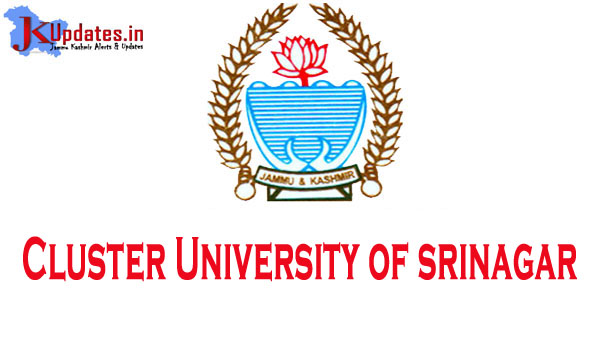Cluster University Srinagar B. Tech. Engineering (Lateral Entry) Syllabus
Applied Mathematics (20)
Marks
Algebra:Partial fractions, Permutation and Combination, Binomial Complex numbers.
Trigonometry:_Angle measurement, trigonometric functions, domain range and period of trigonometric functions, inverse trigonometric functions. theorem,
Co-Ordinate Geometry:Equation of straight line in various standard forms (without proof).Parallel and perpendicular lines, perpendicular distance formula. General equation of a circle and its characteristics. Definition of conics (Parabola, Ellipse,
Hyperbola) their standard equations without proof.
Matrices and Determinants:Definition of matrix and its types. Addition, subtraction nd multiplication of matrices. Expansion of Determinants.
Differential Calculus: Derivatives of basic functions, Chain rule and product rule, Implicit differentiation, Higher-order derivatives, Applications of derivatives in curve sketching.
Applied Physics (20)
Integral Caleulus; Integration techniques (substitution, by parts), Definite integrals andtheir properties, Areas between curves, Volume of revolution, Integration applications in physics and engineering
Units and Dimensions: Fundamental and derived units, SI units, Dimensional analysis and its applications, Unit conversions, Significant figures and measurement uncertainties
Force and Motion: Newton’s laws of motion, Types of forces (gravitational, frictional, normal, tension) Equations of motion (kinematic equations) Projectile motion, Circular motion,centripetal and centrifugal force flow
Rotational Motion: Torque and rotational equilibrium, Moment of inertia, Rotational kinematics and dynamics, rolling motion, Angular momentum Work, Power, and Energy: Work done by a force, Kinetic and potential energy, Conservation of mechanical energy, Power and its calculation, Work-energy theorem Properties of Matter Elasticity and Hooke’s law, Stress, strain, and Young’s modulus, FBuid properties (density, pressure), Surface tension and capillarity, Viscosity and fluid
DC Circuits: Ohm’s law and resistance, Series and parallel circuits, Kirchhoff’s laws (voltage and current laws), RC circuits and time constant, Electrical measurements (voltage, current, resistance)
Electromagnetism: Magnetic field and magnetic force, Electromagnetic induction and Faraday’s law,Lenz’s law and its applications, Magnetic properties of materials,Magnetic field due to a current-carrying conductor Semiconductor Physics: Semiconductor materials and their properties, PN junction anddiode operation, Biasing of diodes (forward and reverse bias), Transistor basics (NPNand PNP), Semiconductor devices and their applications
Note:ThereApplied Chemsitry (20)
Basic concepts of chemistry: Elements, Uses of elements, Extraction of elements,Chemical formula of elements, Periodic table
Solutions: Concept of homogenous solution, lonization, Acidity, Basicity, Equivalent weight, Normality, Morality and Molality.
Electrolvsis: Electrolytes and non-electrolytes, Conductors and non-conductors, Electrolysis, lead acid battery and Ni-Cd battery with special reference to their reaction mechanism.
Polymers: Classification, Methods of polymerization, Polythene, Polyester and Nylon.
Drugs: Antipyretics, Tranquilizers and Antibiotics
Environmental Chemistry: Concept of environmental Chemistry, segments of environment, Air pollution and Water pollution.
Computer Fundanmentals (20)
Basic of Computers, Input-output devices, MSOffice, Hardware and software, Basic concepts of Operating System (OS) like multitasking, memory management, and types of OS, Basics of computer networking, including types of networks and protocols,
Internet and its Applications, Number System (Decimal, Binary, Octal, Hexadecimal), Basics of programming languages, data types, and control structures(C programming).
General Aptitude (10)
Quantitative Aptitude: Profit &Loss, Ratio &Proportion, Average, Time & Work, Speed & Distance (Calculations involving rates, time, and distance travelled), Permutations &Combinations (Understanding arrangements and selections of objects)
Verbal Reasoning: Assessing comprehension, vocabulary, and critical thinking through reading passages and answering questions.
Analogies: Identifying relationships between words or concepts. Statement & Argument Analysis: Evaluating the strength and validity of arguments.
Syllogism: Identifying logical relationships between statements.
Series Completion: Recognizing and continuing numerical or alphabetical patterns.
General English (10)
Basic English grammar: tenses, articles, adjectives, prepositions, conjunctions, verb noun agreement, and other parts of speech.
Basic vocabularv: words, idioms, and phrases in context, reading and comprehension, Narrative sequencing.
Dated: 27-9-24
Click link below:
B. Tech. Engineering (Lateral Entry) Syllabus 27-September-2024



